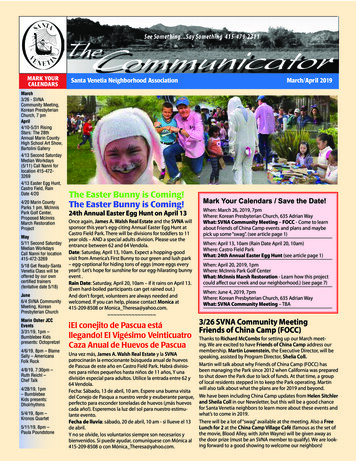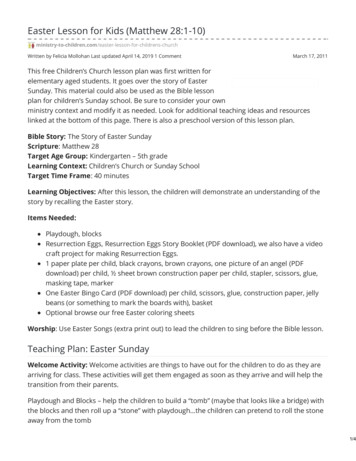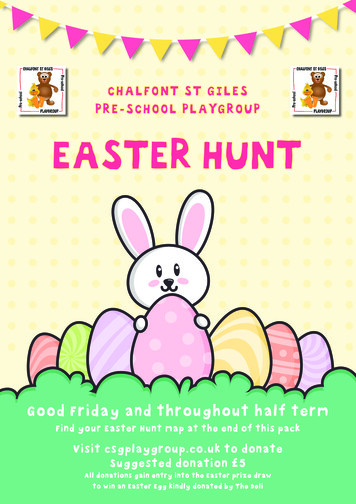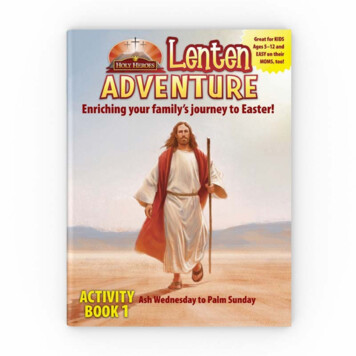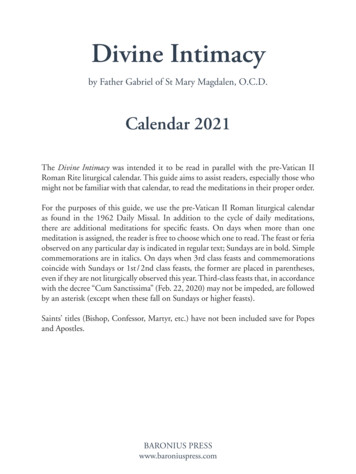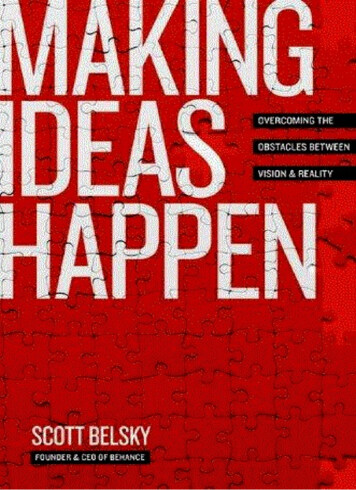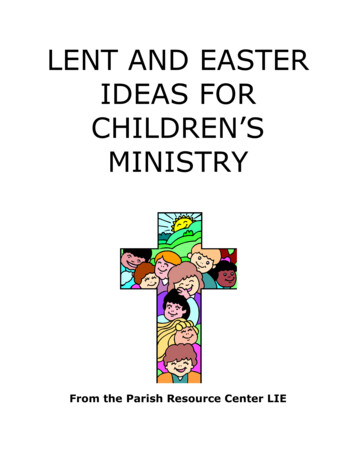
Transcription
LENT AND EASTERIDEAS FORCHILDREN’SMINISTRYFrom the Parish Resource Center LIE
CONTENTS1. An Introduction to Lent and Easter . .Page 32. Telling the Story to Children .Page 43. Food-related Activities*Resurrection Rolls . .Page 5*Easter Cookies Page 64. Crafts*Lenten Prayer Box-Instructions .Page 7-Take Home Sheet . .Page 8-Lenten Symbols Sheet Page 9*Resurrection Eggs-Instructions . Page 10-Scripture Readings for Resurrection Eggs Page 11*Jelly Bean Prayer Bracelets-Instructions . Page 12-Jelly Bean Prayer .Page 13*Stone Tomb . Page 14*Caterpillar/Butterfly Craft .Page 155. Lenten and Easter Word Search . .Page 16-Word Search Solution .Page 176. Websites .Page 182
An Introduction to Lent and EasterThe date for Easter changes each year as it is the first Sunday after the full moonfollowing the vernal equinox on March 21st. Therefore the date falls sometime betweenMarch 22 and April 25.The season of Lent consists of the 40 days, not including Sundays, before Easter. Theword Lent is derived from the Germanic root for long because it is observed in springwhen the days get longer. Lent is a time to prepare for the holiest time of the Christianyear by fasting, prayer, almsgiving, and other acts of penance. Many people give upsomething for Lent (a food, watching TV, etc.) or do something to bring them closer toGod such as daily devotions or charitable donations. The church color for most of Lentis purple which symbolizes repentance as well as royalty. The word alleluia is not usedduring Lent and some churches perform a ritual called the putting away of thealleluias before Lent begins.Ash Wednesday is the first day of Lent. Ashes are a sign of repentance and for centuriesthe words “Remember that you are dust, and to dust you shall return” have beenspoken as the sign of the cross in made with ashes on Christians’ foreheads at specialAsh Wednesday services.Shrove Tuesday is the day before Ash Wednesday and is a time of celebration andeating of rich foods made with eggs, sugar, and butter, which were traditionallyprohibited during Lent. The term shrove is the past tense of shrive which means toobtain forgiveness of sins by confession and doing penance; in the past preparation forLent included going to confession. Other names for the day are Mardi Gras, FatTuesday, Tuesday of Carnival, Fastnacht Day, and Pancake Tuesday. Churches todaycelebrate Shrove Tuesday with Mardi Gras celebrations which may include pancakeraces and dinners of pancakes and other rich foods.Holy Week is the last week of Lent and the week before Easter; it commemorates thelast week of Jesus’ earthly life. It begins with Palm Sunday when Jesus enteredJerusalem, continues with Holy Monday, Holy Tuesday, and Holy Wednesday, andends with Maundy Thursday (Holy Thursday), Good Friday and Holy Saturday. Theword Maundy is thought to be derived from the Latin word for command and refers tothe command Jesus gave to his disciples at the Last Supper. The time from the eveningof Holy Thursday until the evening of Easter Sunday is called the Easter Triduum. ATenebrae service may be held on Maundy Thursday or Good Friday; the wordTenebrae is Latin for shadows and the service includes a gradual extinguishing ofcandles. In Roman Catholic and some other churches there is an Easter Vigil betweensunset on Holy Saturday and dawn on Easter Sunday which is considered the firstofficial celebration of the resurrection of Jesus.3
Telling the Story to ChildrenTeaching children about Christmas is fun and easy compared to the challenge ofteaching them about Lent, Holy Week, and Easter. Memories of the little baby born inBethlehem are still fresh in their minds when the season of Lent begins; how do weexplain that the little baby grew up to suffer and die? In a society of instant gratificationand “it’s all about me,” a season which emphasizes repentance and sacrifice can be ahard sell. It may be tempting to de-emphasize Lent, teach about Palm Sunday andEaster Sunday and forget the rest but we’re doing our children a disservice when wetake that route. The joy of Easter can’t be fully experienced without some knowledge ofwhat happened on Good Friday, and learning about Lent and that we should lookbeyond ourselves and our needs is a valuable lesson.It’s important to be aware of what is age-appropriate for children and be conscious ofeach child’s particular sensitivities and level of understanding. Children younger thanthree can be told that Jesus is alive and with us today. For preschool children, a simpleexplanation that Jesus died on a cross, was buried in a tomb, and then rose on EasterSunday is sufficient. Younger elementary children can hear stories from the gospelswithout going into too much detail. Older elementary children can be exposed to moreparticulars of Maundy Thursday and Good Friday. Whatever we teach our childrenabout the events leading up to Jesus’ death, it’s important to always include the story ofJesus’ resurrection and what it means for us today.There are many good Easter books and videos for children but always preview themfirst to make sure they match your beliefs, are not too violent, and include theresurrection as well as Jesus’ death.When questions arise, answer them honestly. Don’t be afraid to tell the children thatyou struggle with some of their same concerns. For younger children, a simpleexplanation such as telling them that Jesus died for us so that we could be together withhim in heaven is usually sufficient.In observing the season of Lent, it’s best to inspire, not require. Some children may findthe practice of giving up a favorite food or TV show meaningful; others may prefer toadd something, such as collecting money for the poor or being kind to others. Sharewith them how you observe Lent and what practices you find meaningful and invitethem to decide what they would like to do. If you are in children’s ministry make sureto send home appropriate Lenten activities for families to practice together such as aLenten calendar, daily devotional, prayers for each week, etc.4
Food Related ActivitiesResurrection RollsThese treats are not only delicious but also a good way of emphasizing the point thatthe tomb where Jesus was laid was empty on Easter morning. If you are a Sundayschool teacher you can make these rolls with the children in the church kitchen or makethem at home ahead of time.Ingredients*can of refrigerated crescent rolls*8 marshmallows*1/4 cup melted butter*2 Tbs. ground cinnamon*2 Tbs. sugar1. Preheat oven to 400 degrees. Lightly grease a baking sheet.2. Separate crescent rolls into individual triangles.3. Mix the cinnamon and sugar together in a small bowl.4. Give each child a marshmallow and tell them it stands for Jesus and his purity.5. Have the children dip their marshmallow into the melted butter and cinnamon/sugarmixture. The butter and cinnamon/sugar are like the oil and spices that were rubbed onJesus’ body.6. Give each child a crescent roll triangle and explain that this represents the cloth thatJesus’ body was wrapped in. Have the child completely wrap the triangle over themarshmallow and seal the edges together.7. Place in the oven for 10-12 minutes until golden brown. Explain that the oven is likethe tomb Jesus was placed in.8. When the rolls have been removed and cooled, have the children open their “tombs”to see that they are empty inside. Jesus has risen! (The marshmallow melts but the rollremains puffed up—empty.)5
Easter CookiesThese cookies are a great way to reinforce the lesson of the empty tomb on Eastermorning. Teachers can prepare them at home and bring them to class for their studentsto enjoy. The recipe can also be sent home with the suggestion that parents prepare thecookies the night before Easter Sunday.Ingredients*1 cup whole pecans*1 tsp. vinegar*3 egg whites*pinch of salt*1 cup sugar*wooden spoon*Ziploc bag1. Preheat oven to 300 degrees.2. Put pecans in Ziploc bag and let the children break them into small pieces with thewooden spoon. This shows how Jesus’ body was broken on Good Friday.3. Have the children smell the vinegar as they put 1 tsp. of it into a mixing bowl. Tell thechildren when Jesus was thirsty on the cross he was given vinegar to drink.4. Add the egg whites to the vinegar. Explain to the children that the eggs represent lifeand that Jesus gave his life so we could have eternal life with him.5. Sprinkle a little salt into the children’s hands. Let them taste it and tell them it standsfor the salty tears shed by Jesus’ followers when he died. Put a pinch of salt into thebowl.6. Tell the children that so far the ingredients don’t seem very tasty, but now we aregoing to add 1 cup of sugar to them because the sweetest part of the story is that Jesusdied because he loves us.7. Beat the mixture with a mixer on high speed for 12-15 minutes until stiff peaks form.Tell the children the white color represents that we are pure because our sins have beencleansed by Jesus.8. Fold in the broken nuts and drop by teaspoons onto a cookie sheet covered with waxpaper. Explain that each mound represents the rocky tomb where Jesus’ body was laid.9. Put the cookie sheet in the oven, close the door and turn the oven off.10. Tell the children that the cookies will be left in the oven while they sleep, just asJesus’ followers slept as he lay in the tomb.11. On Easter morning, give the children a cookie and let them take a bite and see thatthey are hollow. Jesus’ followers were amazed when they went to the tomb on Easterand found it empty; Jesus had risen from the dead!6
CRAFTSLenten Prayer BoxHave each child decorate a Lenten Prayer Box to take home and use with their familiesUse the sample box you’ve made for classroom prayers during Lent.Supplies*cardboard boxes*Lenten/Easter symbols sheet*glue sticks*scissorsBoxes can be purchased at party stores or you can cover shoeboxes with whitewhit paper.The Material Resource Center in Ronkonkoma urcecenter.org) oftensells inexpensive boxes.Instructions*Hand out the Lenten/Easter symbols sheet and have the children color theth symbols asyou talk about the meaning of each one.*Have the children cut out the symbols and glue them onto the boxes.*HandHand out the instruction/prayer requests sheets and explain to the children how to usethem at home.*Pass out slips of the prayer requestsequests and have the children fill them out. Let them sharetheir prayer requests with the class if they want to. Collect the prayer requests and putthem in the classroom Lenten box.7
Lenten Prayer Box Take Home SheetDear Parent/Guardian,Today your child made a Lenten prayer box to use at home. We would like toencourage you to set a regular time to write up prayer requests for the box and praytogether as a family. A good time to do this is during a meal, at bath time, or before bed.Your child is looking at you to model the Christian faith so be sure to let them knowhow much you value the importance of prayer.Blessings,Your child’s Sunday school teacherMy prayer request isMy prayer request isMy prayer request isMy prayer request isMy prayer request is8
Lenten Symbols9
Resurrection EggsThese can be purchased but why not make youown set and have your students make them totake home? It’s a great way for the children tolearn about the events of Holy Week. As thechildren fill each egg read the scriptures anddiscuss.Supplies for each set*12 plastic Easter eggs that open*egg carton or basket or bag (to place eggs in)*small artificial plant leaf*small piece of cloth with perfume on it*piece of brown clay shaped into a small bread loaf*3 dimes or play silver coins*thorn or small piece of thorny branch*piece of purple cloth*small cross or two toothpicks tied together to form a cross*swatch of burlap*small piece of sponge*2 or 3 whole cloves*small pieces of paper with scripture readingsInstructions*Use a permanent marker to write the numbers 1-12 on each egg.*Put the items and scripture reading in each numbered egg as follows:#1 – Palm Sunday: small artificial plant leaf/Matthew 21:8-9#2 – Mary pours expensive perfume on Jesus’ feet: cloth with perfume/John 12:3#3 – Last Supper: brown clay shaped into bread loaf/Matthew 26:17-19#4 – Judas betrays Jesus for 30 pieces of silver: dimes or plastic money/Matthew 27:3#5 – Soldiers place crown of thorns on Jesus’ head: thorn/John 19:2a#6 – Soldiers place purple robe on Jesus: purple cloth/John 19:2b#7 – Jesus carries his cross: cross/John 19:17#8 – Soldiers part Jesus’ clothes and cast lots for his coat: burlap/John 19:23#9 – Jesus is given wine and gall on a sponge to drink: sponge/Matthew 27:34#10 – Spices are used to prepare Jesus for burial: cloves/John 19:40#11 – The stone covering Jesus’ tomb was rolled away: rock/John 20:1#12 – Jesus’ resurrection: the last egg is empty just as the tomb was.10
Scripture Readings for Resurrection Eggs (NIV Translation)Egg #1: Matthew 21:8-9A very large crowd spread their cloaks on the road, while others cut branches from the treesand spread them on the road. The crowds that went ahead of him and those that followedshouted, "Hosanna to the Son of David!" "Blessed is he who comes in the name of the Lord!""Hosanna in the highest!"Egg #2: John 12:3Then Mary took about a pint of pure nard, an expensive perfume; she poured it on Jesus' feetand wiped his feet with her hair. And the house was filled with the fragrance of the perfume.Egg #3: Matthew 26:17-19While they were eating, Jesus took bread, gave thanks and broke it, and gave it to his disciples,saying, "Take and eat; this is my body."Egg #4: Matthew 27:3When Judas, who had betrayed him, saw that Jesus was condemned, he was seized withremorse and returned the thirty silver coins to the chief priests and the elders.Egg #5: John 19:2aThe soldiers twisted together a crown of thorns and put it on his head.Egg #6: John 19:2bThey clothed him in a purple robe.Egg #7: John 19:17Carrying his own cross, he went out to the place of the Skull (which in Aramaic is calledGolgotha).Egg #8: John 19:23When the soldiers crucified Jesus, they took his clothes, dividing them into four shares, one foreach of them, with the undergarment remaining. This garment was seamless, woven in onepiece from top to bottom.Egg #9: Matthew 27:34There they offered Jesus wine to drink, mixed with gall; but after tasting it, he refused to drinkit.Egg #10: John 19:40Taking Jesus' body, the two of them wrapped it, with the spices, in strips of linen.Egg #11: John 20:1Early on the first day of the week, while it was still dark, Mary Magdalene went to the tomb andsaw that the stone had been removed from the entrance.11
Jelly Bean Prayer BraceletsGo over the Jelly Bean Prayer before you make this project and send home a copy withthe completed bracelets.Supplies*12 inch lengths of leather lacing*beads in the following colors: red, green, yellow, orange, black, white, purple, and pinkInstructions*Give each child a copy of the Jelly Bean Prayer, a 12” length of leather lacing, and onebead of each color.*Have the children make a knot at one end of the leather lacing to hold the bead inplace. This knot can also remind the children that they’re held tightly in God’s lovingarms. As the children make knots in the bracelet have them think of them as hugs fromGod.*Have the children put a red bead on the leather lacing and read the first line of thepoem. Let them know that Jesus died for them because he loves them.*Make another knot.*Add the green bead to the bracelet and read the next line of the poem. Give thanks thatGod made the world.*Add another knot.*Put a yellow bead on the bracelet and read the appropriate line of the poem. ThankGod for making the sun.*Make a knot.*Add the orange bead and read the next line. Give thanks that God is with us day andnight.*Add a knot.*Put the black bead on and read the appropriate line. Ask God to forgive us when wedon’t do what is right.*Add a knot.*Add the white bead and assure the children that God forgives us when we ask.*Add another knot.*Add a purple bead and read the next line of the poem. Explain that purple is the colorof Lent and sadness and that it was sad that Jesus died.*Add a knot.*Put the pink bead on and read the next line of the poem. Let the children know thatJesus died but then he rose from the dead so that we can be with him forever when wedie.*Tie the ends of the bracelet together.*Let the children have a jelly bean of each color for a snack.12
JELLY BEAN PRAYERRED IS FOR THE BLOOD HE GAVE.GREEN IS FOR THEHE GRASS HE MADE.YELLOW IS FOR THE SUN SO BRIGHTBRIGHT.ORANGE IS FOR THE EDGE OF NIGHT.BLACK IS FOR THE SINS WE MADE.WHITE IS FOR THE GRACE HE GAVE.PURPLE IS FOR HIS HOUR OF SORROW.PINK IS FOR OUR NEW TOMORROW.A BAG FULL OF JELLY BEANSCOLORFUL AND SWEET,IS A PRAYER, IS A PROMISE,IS A SPECIAL TREATMAY THE JOY OF CHRIST'S RESURRECTIONFILL YOUR HEART AND BLESS YOUR LIFE.Note: In addition to making the Jelly Bean Prayer Bracelet or instead of making it, youmay give each child a jelly bean of the variousarious colors in the poem, wrap in fabricnetting, and tie with a bow.13
Stone TombThis activity is simple enough for children to do but is also enjoyed by youth andadults.Supplies*plastic soup bowl*stones (aquarium stones can be purchased from a pet store)*2 craft sticks*cross and sun patterns*oakoak tag (either gray or white)*craft glue or cool glue gun*8” foam or plastic plate*Easter grass or Spanish mossInstructions*Turn bowl over and cut an opening of approximately 1” x 1” in the bottomom front,front tomake an opening to the “tombb.”*Cut a circle of oak tag large enough to cover tomb opening. If using white oak tag,color the circle gray with crayons or markers.*Push a craft stick throughhrough the back top of the bowl and leave the slit opeen.*Dip stones in glue and stick on inverted bowl; cover it comcompletelypletely with stones.*Cut out the sun and cross.*Glue the sun to the top of one craft stick and the cross to the top of the other craftcr stick.*Spread glue on the 8” plate.*Place the tomb (bowl) in the center of the plate and arrange grass around it.*Insert the cross on craft sticktick in the slit in the top of the tomb. Change it to the sun onEaster.ALLELUIA!HE ISRISEN!14
Caterpillar/Butterfly CraftThe butterfly is a wonderful Easter symbol and a great way to teach children how Jesusrose from the dead and about the new life we have through Jesus. The caterpillar spinsa cocoon (chrysalis) and goes inside to sleep; from the outside it looks like it’s dead butinside the cocoon wonderful changes are taking place. When the caterpillar emerges ithas been transformed into a beautiful butterfly!Supplies*coffee filters*watercolor markers*chenille sticks*empty toilet paper rolls*brown package wrapping paper (or brown grocery bags)*scotch tape or glueInstructions*Give each child a coffee filter and have them open it out and press it flat. Let themdecorate the filter with the markers. Watercolor markers tend to bleed and makeinteresting designs.*Give each child a chenille stick and have them fold it in half.*Then, have the children scrunch their filters in the middle and wrap the chenille sticksaround the middle of the filter and twist, bending the ends to form antennae. Gently fanout the filters to form wings.*Give each child a toilet paper roll and piece of brown paper cut to approximately 8” x8”.*Have the children carefully fold the butterflies’ wings and put the butterflies into thetoilet paper rolls. Wrap the toilet paper rolls in the brown paper and tape or glue thepaper in place along one side, and then twist the paper at the top and bottom of the rollto seal the cocoon.*Have the children open their cocoons on Easter morning to release their butterflies!15
Lent and Easter Word CDKMRHGIYFQ
Word Search Solution BJ UBE C TM R P R TO U A Y O ET SSLLLS R LAIMSE F E LL SJG L Z E E N Y T AMS A ESEHSA N U R N S ,3,W)17P A PASSOVER S EGGS O H
Websites to Visit for More Lenten Activity IdeasWebsites with Lent and Easter LessonseBibleTeacher.comLessons, worksheets, printable Bible trading cards, music, ldren.comFree lessons, activities, downloadable activity books, articles, and more.http://ministry-to-children.com/Mission Arlington ChurchFree downloadable children’s curriculum available in English and Spanish.www.missionarlington.com/MSSS Crafts and Resources for Bible StoriesHas many links to lessons, crafts, games, etc. for Bible stories -- excellent sitewww.mssscrafts.comWebsites with Coloring Pages and Activity SheetsCalvary ChapelBible crosswords, activity sheets, coloring pages, etc. for many Old Testament and NewTestament stories - all are also available in ulum.htmSermons for KidsHas children’s sermon ideas and coloring sheets in English and Spanish.www.sermons4kids.comWebsite to Make Your Own PuzzlesPuzzlemakerCreate and print customized word search, crossword and math puzzles using yourword lists.www.puzzlemaker.comWebsite with Free Lent Activities for the Family Booklet Including a Lenten ntenTree.pdf18
the tomb where Jesus was laid was empty on Easter morning. If you are a Sunday school teacher you can make these rolls with the children in the church kitchen or make them at home ahead of time. Ingredients *can of refrigerated crescent rolls *8 marshmallows *1/4 cup melted butter *2 Tbs. ground cinnamon *2 Tbs. sugar 1. Preheat oven to 400 .

